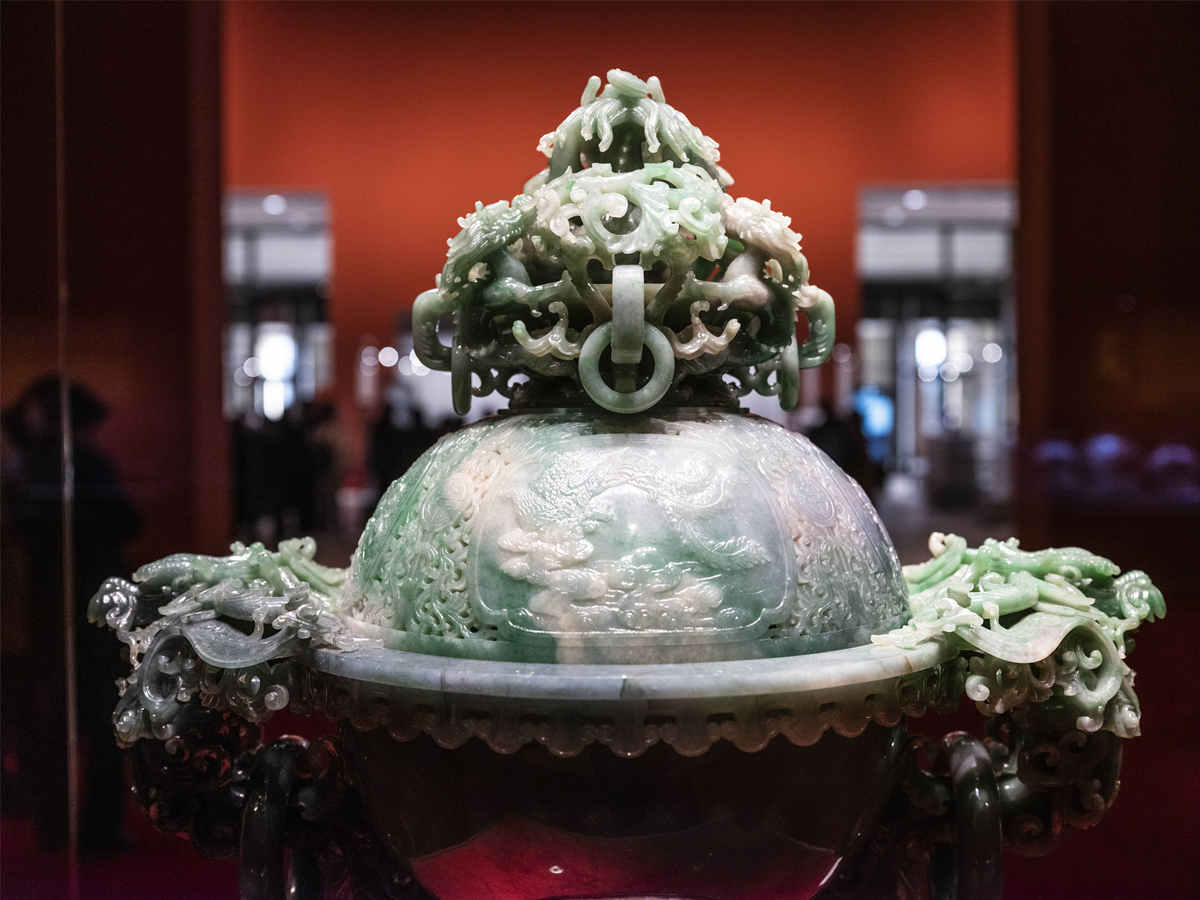An Intangible Cultural Heritage Museum on the Central Axis

With a total floor area of 91,126 square meters, China Intangible Cultural Heritage Museum, also known as the China National Arts and Crafts Museum, is situated on the northern extension of the Central Axis of Beijing. It took nearly three years from March 2019 when its construction broke ground to its official opening in February 2022 as a new cultural landmark on the city’s Central Axis.
The opening exhibition of the museum, “Treasures of China: An Exhibition of Chinese Intangible Culture Heritage and Arts and Crafts,” features a total of 1,298 pieces of exhibits, nearly a thousand of which first debuted to the public.

Meditation Link designed by Wang Xiaoxin, copper and gold, 28x28x28cm,2019.
According to the museum, the exhibits are divided into different sections including arts and crafts, guqin (Chinese zither), copies of Silk Road murals, inscriptions and seal cuttings, and traditional musical instruments, operas and performing arts. Wandering the exhibition halls, visitors can engage in dialogue with the millennia-old Chinese civilization through sculptures, musical instruments, clothing, calligraphy, paintings, and other intangible cultural heritage items while discovering unexpected cultural treasures.
Chinese arts and crafts are the essence of traditional Chinese culture and exert important influence worldwide. They are also intangible cultural heritage with great vitality and potential for inheritance and development.

Exquisite traditional opera costumes displayed in the “Opera Legend” section.
The first section of the exhibition, “Craftsmanship of a Great Nation,” is located in the south exhibition hall on the first floor and displays masterpieces of Chinese arts and crafts since the founding of the People’s Republic of China in 1949. Among them, the four jade carving works dubbed “national treasures” are the most eye-catching. They are Wonderful View of Mount Tai, Containing Fragrance and Good Luck, Blooming Flowers, and Universal Joy. The four works were made of a rare large jadestone. With exquisite design and careful polishing by more than 40 jade carving masters and dozens of experts and scholars, they lifted Chinese jade carving craft to the next level.
The guqin is a representative of Chinese musical instruments. In the second section of the exhibition, “Music from Ancient Times,” visitors can not only see extremely precious and famous guqins handed down from the late Tang Dynasty (618-907) and the Southern Song Dynasty (1127-1279), but also enjoy guqin music in an immersive manner.
The “Silk Road Paintings” section leads visitors to trek eastward along the Silk Road from the Qiuci Grottoes to the Dunhuang Grottoes for a millennium spanning the fourth to the fourteenth centuries. More than 70 copies of murals are on display, the largest and most extensive scale in China in terms of reproductions and research of clay murals.

Zhao’s Flute Musical Score of Kunqu Opera, an important ancient musical score collection in eight volumes dating back to 1844 during the Qing Dynasty (1644-1911).
The “Opera Legend” section in the north exhibition hall on the fourth floor focuses on costumes and props from Kunqu Opera, Cantonese Opera, Tibetan Opera, Peking Opera, Chinese Shadow Puppetry, and other traditional operas that have been inscribed on the Representative List of the Intangible Cultural Heritage of Humanity. Various costumes, exquisite headdresses, and weapon props caught visitors’ eyes.
Visitors can closely observe typical materials from different kinds and forms of traditional Chinese operas and feel the charm of opera arts from various regions. In the center of the exhibition area, videos of Peking Opera performances are projected on an exquisite stage, where people can enjoy them while resting.
Chinese calligraphy and seal cutting are also important symbols of the endless and uninterrupted Chinese civilization. In the sixth section, visitors can appreciate hundreds of seal cutting works by the most representative contemporary seal carvers from China and abroad, inspired by epigrams from Chinese classic The Analects of Confucius. The works have high calligraphic, literary and aesthetic value.
People can also appreciate replicated murals from the Silk Road in the “Silk Road Paintings” section and learn stories about experts’ efforts in the conservation and innovation of replicated media, pigments, painting techniques, mural content, and artistic styles of the murals.
In addition,, various activities are presented at the exhibition to promote intangible cultural heritage such as traditional opera shows, folk music and art performances, and academic lectures.